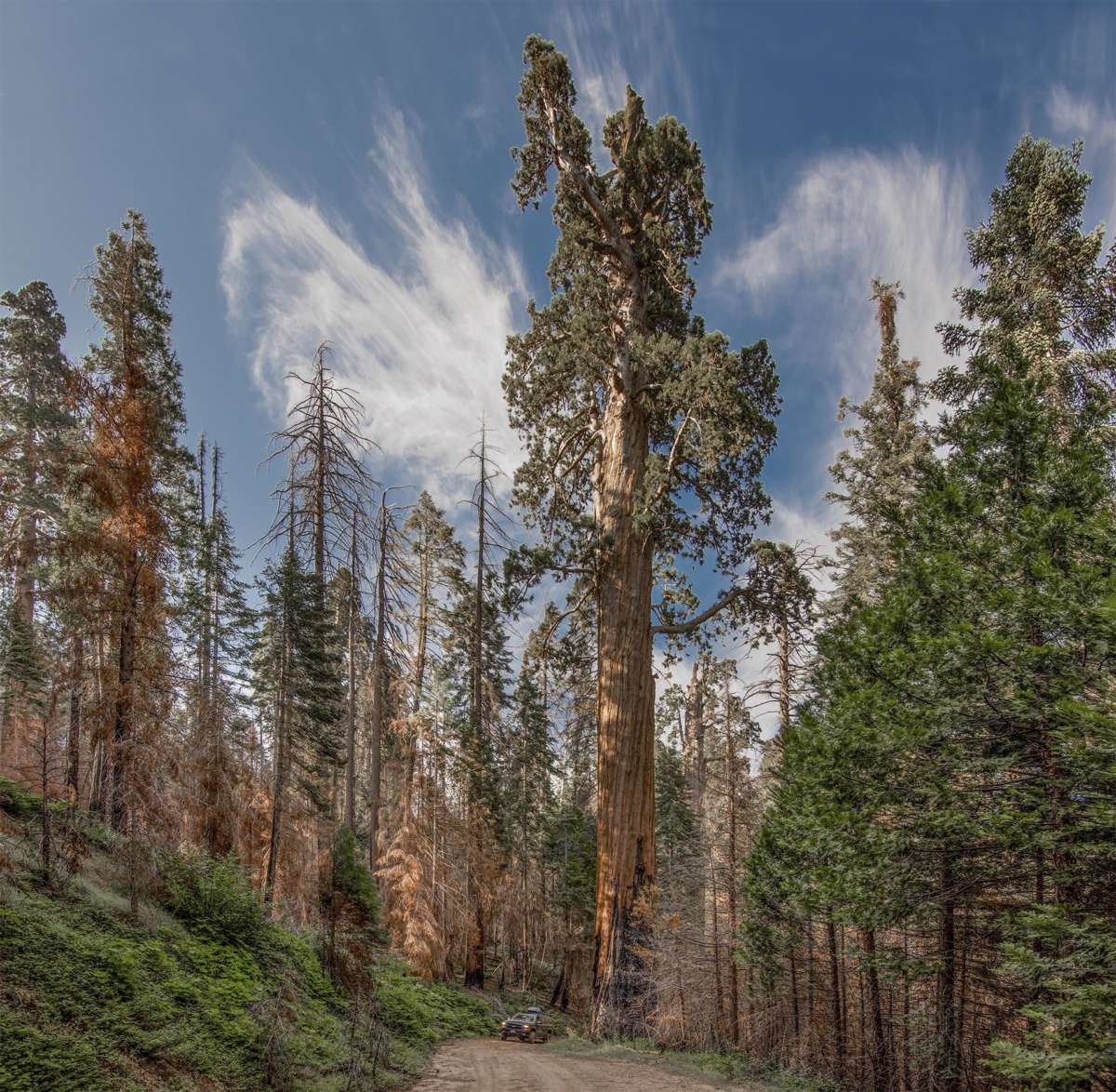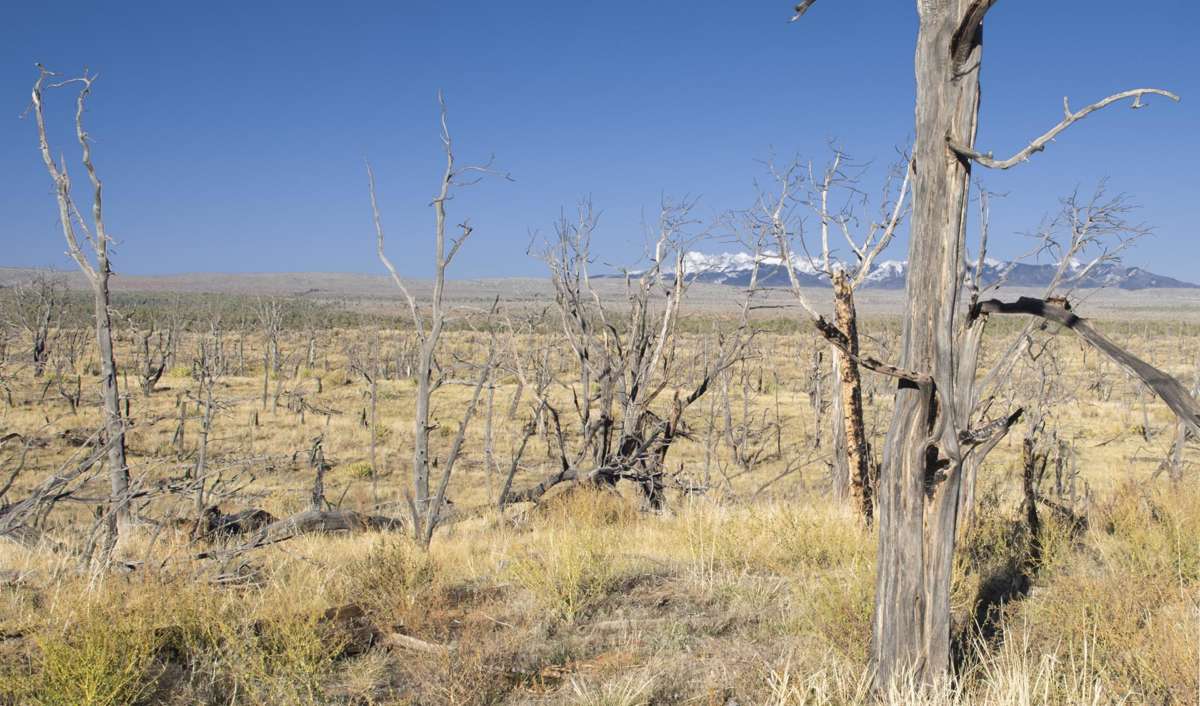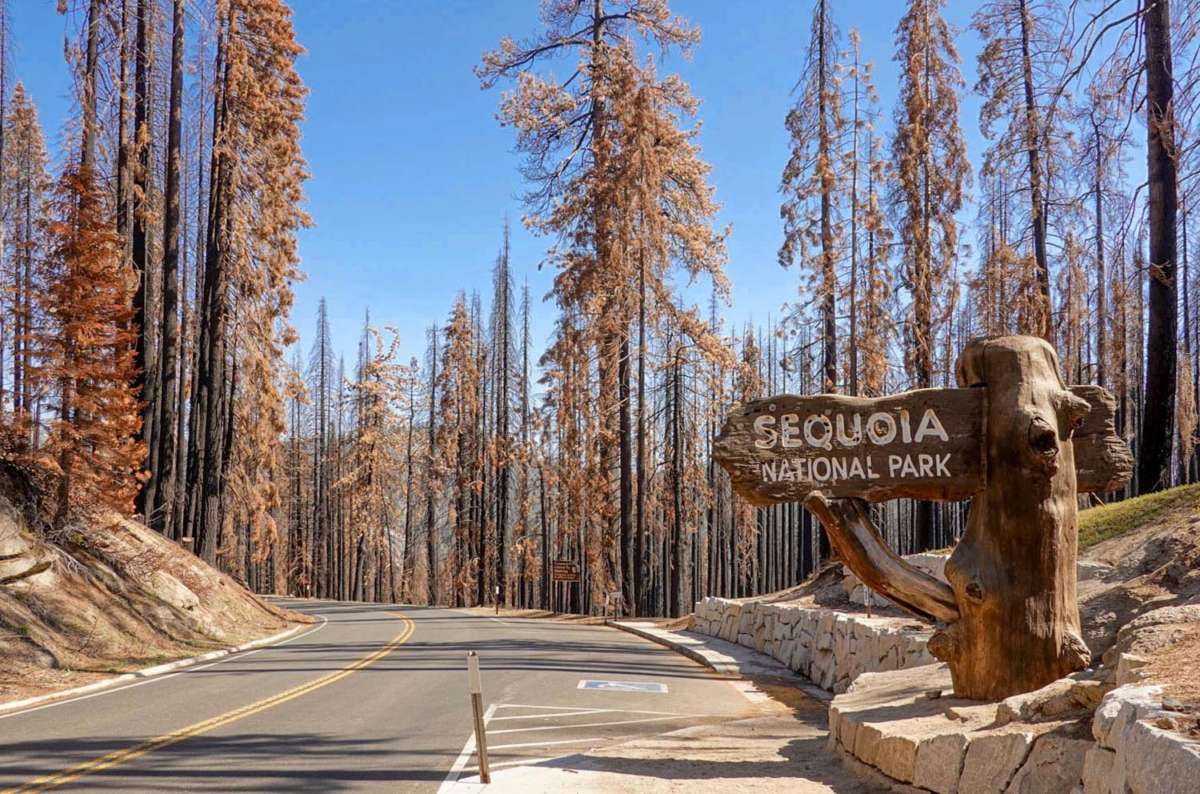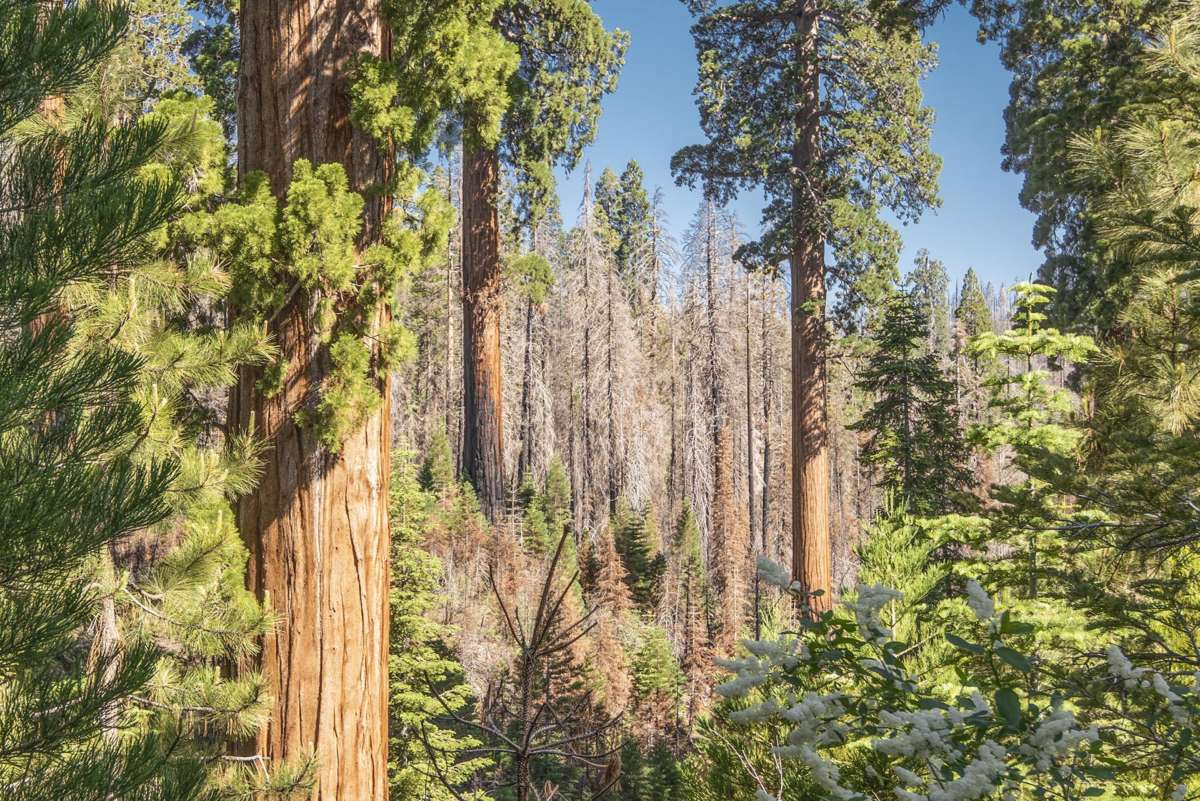Part of the Series
Covering Climate Now
Climate change is killing giant sequoias in numbers that portend ecological disaster unless radical action is taken to reverse the impacts of the climate crisis. Sequoias, once deemed “unburnable,” began to be widely destroyed by fire in 2015, and then in 2020 and 2021, California fires tripled in area covered. The current best count of mature sequoias killed by increased fire intensity since 2015 is more than 13,000. There are only about 75,500 mature sequoias in existence. The National Park Service defines mature sequoias as those greater than 4 feet in diameter.
There are about 73 giant sequoia groves in existence and more than 85 percent burned between 2015 and 2021. In the preceding 100 years, only 25 percent of groves burned.
“Large sequoias typically died by falling or, occasionally, having extensive crown scorch from fire,” where “crown scorch” is fire that kills but does not consume tree needles. The National Park Service continues, “Death while standing, unrelated to crown scorch, was almost never observed by scientists who had spent decades working in the Sierra Nevada. And while mature giant sequoias did die from fire impact, that was a relatively rare event, typically the result of many accumulated injuries over their long lives.”
Some of these sequoias could have been 3,000 years old. They have achieved these great ages while battling fire time and time again, evolving to be nearly fire-proof. Their spongy asbestos-like bark can be two to three feet thick. They don’t have flammable resin like almost all other conifers, and their great height, where their lowest branches can be 150 to 200 feet above the ground, allows them to tower over the other forest trees that when in flame are far below the needles of sequoias.

“The hotter drought of 2012-2016 appears to have been a tipping point for giant sequoias and other Sierra Nevada mixed-conifer forests,” the National Park Service reports. “In hotter droughts, unusually high temperatures worsen the effects of low precipitation, resulting in greater water loss from trees and lower water availability. This is an emerging climate change threat to forests.”
Across the West and Southwest, global warming has resulted in increased evaporation and what could be labeled perpetual drought, which has led to massive tree mortality from drying and drying-induced attacks from native bark beetles agitated from warming. In California, 172 million trees have been killed by drought, disease and beetles since 2010, and 100 to 200 million were killed in fires in 2021 alone. During Texas’s record drought between 2011 and 2013, more than 300 million trees were killed, and the state’s ongoing drought is now more severe than the last. Across the North American West, 100 million acres of forest have been significantly impacted or mostly killed by native bark beetles since 2017.
In 2022, New Mexico had its two largest wildfires ever recorded over the course of a year. In 2020, Colorado had its three largest wildfires ever recorded in one year. The eight largest wildfires California has ever seen have happened since 2017. All but one of these new record fires in California were larger than 300,000 acres. The two largest fires ever recorded in California were 1 million acres each, in 2020 and 2021. The seven largest fires in California history burned since 2018. The largest wildfires in California doubled in size from the 2000s to 2018, and doubled again in 2020 to 1 million acres per fire.
The prevailing discussion about the cause of this threshold passing is that wildfire suppression for the last 100 or 200 years has allowed forest fuels to increase, which in combination with warming and increased drought from climate change, have increased high-severity fire up to 800 percent since 1985. High-severity fires kill about 95 percent of tree species and drier conditions post-fire limit regeneration with an increased risk of conversion of forests to alternative vegetation types like shrub and grasslands.
Across the American West, a third of fires burning around the turn of the century are not regenerating, where seedlings from the former forest are not surviving because it is now too dry. These forests are coming back as shrubs or grasslands. Of those fires that do show some regeneration, half are only regenerating at half the 20th century rate. We have entered an era where pre-fire forests may not return. Without the forests, forest species do not return. Forests are also cloud machines, when they are gone, the clouds leave too.
This failure of regeneration is profound. An astonishing example of forest conversion to grassland is the result of fires in Colorado’s Mesa Verde National Park from 1998 to 2001. They burned more than half of the forests in the park and almost all of the forests on the mesa tops. The ancient Puebloans used these forest resources for subsistence, with drought being the likely cause of the abandonment of their cliff dwellings 700 years ago. During and since that time, the mesa top forests persisted. Climate change has now taken that pinyon/juniper woodland that remained after the Puebloans retreated, and replaced it with a grassland that has not yet begun to regenerate after 20 years. In itself, this is only natural, but what are the wider implications?

In addition to increased fuels, six climate change-caused fire enhancing behaviors are also increasing area burned and the severity of fires: record dry fuels from climate change drought, record low humidity, higher temperatures creating easier ignition and more extreme burning, record wind storms, longer drying with earlier spring and later onset of fall conditions, and increased nighttime fire behavior. Because of these factors, the California Department of Forestry and Fire Protection (CAL FIRE) says fires are now burning 400 degrees hotter.
Scientists have warned for 30 years that climate tipping systems could activate if we delayed action on dealing with climate pollution. Tipping systems are Earth systems like the Amazon or permafrost. They can absorb a lot of abuse from factors like drying, fires and hotter temperatures, until at some point the species that make up these systems, or the ice in permafrost, collapses. These tipping systems are the irreversible climate change impacts that were previously not supposed to happen until the end of the century with continued warming. When tipping systems collapse, their environmental services are degraded, eliminated or reversed. One of the most important of these environmental services is carbon dioxide sequestration. For instance, Canadian forests are now in collapse due largely to native bark beetle breakouts and are now emitting, not absorbing, 250 million tons of greenhouse gasses per year as of 2020. Permafrost is emitting, not absorbing, 2.3 billion tons of greenhouse gasses every year, and the Amazon too has now flipped, emitting and not absorbing 1 billion tons of greenhouse gasses every year.
A 2019 article in the journal Nature revealed that tipping was now active in half of known tipping systems, when widespread consensus was that tipping was not supposed to activate until 5 degrees Celsius warming in the year 2100 or later. These tipping systems that are now active include: Arctic sea ice, Greenland ice sheet, boreal forests, permafrost, the Gulf Stream, the Amazon, coral, the West Antarctic Ice Sheet and parts of the East Antarctic Ice Sheet.
Tipping, or Earth systems collapse, happens when the evolutionary boundary conditions of those systems are exceeded. This is simple systems evolution where conditions become hostile to the species that have evolved in that system resulting in those species collapsing with new species tolerant of the changed condition evolving the system anew.

A climate change threshold has been crossed. We have warmed beyond the evolutionary boundaries of our Earth’s systems. “Starting in 2015, higher-severity fires have killed mature giant sequoias (those 4 feet or greater in diameter) in much greater numbers than has ever been recorded,” the National Park Service reports. “We have reached a tipping point — lack of frequent fire for the past century in most groves, combined with the impacts of a warming climate — have made some wildfires much more deadly for sequoias.”

The evolutionary boundaries of our Earth’s systems are what made our advanced civilization what it is. Earth’s systems evolved within the boundaries of our old climate and our advanced human civilization evolved dependent upon our Earth’s systems. Without these systems, can our civilization survive? Can we adapt? When the forests fail to regenerate, do we get all our goods from plastic or metal? Where does the water go that the forests provided, that watered our crops, ourselves, and our industry? Where do the jobs go when the forests are gone?
Additional warming to the established 1.5°C target ensures that these prematurely activated tipping collapses are complete and become irreversible. These Earth systems that are now in tipping collapse are far more than just the green on the surface, or the fish in the seas, or the unseen biota in our soils. They have environmental services that we depend upon for a stable climate.
Earth’s species matter. A stable sea level matters. Sequoias — some of the oldest and most noble things on the planet — they matter. They are the harbingers. Earth’s system collapses do not self-restore unless the perturbation is removed; unless the warming is removed.

What we need to do now is become motivated to reduce our climate culture’s warming target from 1.5°C, to less than 1°C to prevent these already activated climate tipping systems from becoming existentially irreversible.
The author would like to thank Sue Cag, whose photography provided a tremendous firsthand look at the giant sequoia casualties.
A longer version of this article with in-depth references appears at Climate Discovery.
Our most important fundraising appeal of the year
December is the most critical time of year for Truthout, because our nonprofit news is funded almost entirely by individual donations from readers like you. So before you navigate away, we ask that you take just a second to support Truthout with a tax-deductible donation.
This year is a little different. We are up against a far-reaching, wide-scale attack on press freedom coming from the Trump administration. 2025 was a year of frightening censorship, news industry corporate consolidation, and worsening financial conditions for progressive nonprofits across the board.
We can only resist Trump’s agenda by cultivating a strong base of support. The right-wing mediasphere is funded comfortably by billionaire owners and venture capitalist philanthropists. At Truthout, we have you.
We’ve set an ambitious target for our year-end campaign — a goal of $250,000 to keep up our fight against authoritarianism in 2026. Please take a meaningful action in this fight: make a one-time or monthly donation to Truthout before December 31. If you have the means, please dig deep.
